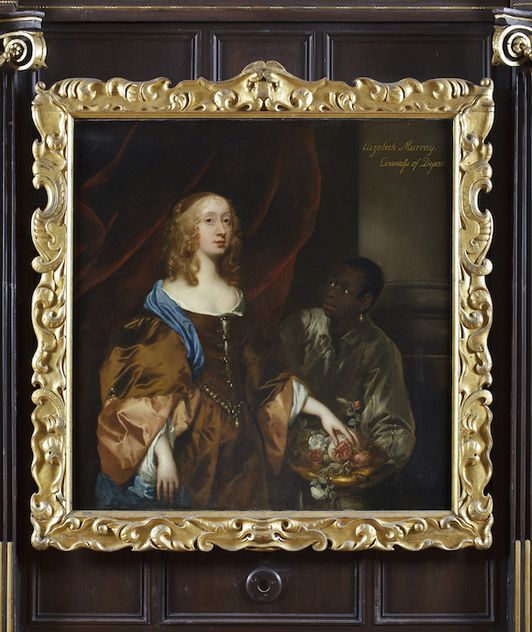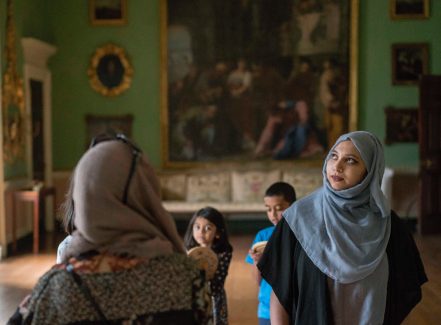In Peter Lely’s 1651 portrait at Ham House, the Countess of Dysart stands stiff as starched lace, clad in blue and bronze silk. A black servant bends towards her, proffering a plate of roses. She gazes coolly out at the world; he looks up at her, perhaps admiring, perhaps wary. We don’t know his name. That’s often the case, though not always: the young black man kneeling at the feet of John Spencer (the six-times great-grandfather of Diana, Princess of Wales), painted by George Knapton in 1744, was a slave called Caesar Shaw. In the 17th and 18th centuries, it was fashionable for rich white people to be painted with a black person carrying fruit or flowers, holding the horse’s bridle or the dog’s collar. There are scores of these portraits in museums and country houses, bearing testimony to the often overlooked black presence in the British past.
But after the world watched Derek Chauvin murder George Floyd on 25th May 2020, the voices demanding Britain confront both state violence against people of colour and the nation’s slaveholding past grew louder. Black Lives Matter protests hit the streets in London, Liverpool, Bristol, Glasgow and other cities. In response, Boris Johnson (a man who once referred to “cheering crowds of flag-waving picaninnies” greeting the Queen on Commonwealth tours) established the Sewell Commission on Race and Ethnic Disparities in July 2020.
As the ghosts of empire began to make themselves heard, conservatives feared that Britain was importing what Daily Telegraph columnist Calvin Robinson—who is himself black—referred to as our American racial “drama.” Responding to the British Black Lives Matter movement, as well as the outrage over the nothing-to-see-here Sewell report which came out in May, Robinson insisted that the UK is a “nation that has thrived on building a multi-ethnic society with equal opportunities for all.” The way conservatives want to cancel the story of how Britain was greatly enriched by slave plantations in the West Indies, and continues to be marked by institutional prejudice, is similar to the way the right wing in my home country of the United States likes to equate even talking about race with attacking white people and trying to destroy great figures of the past.
Until 2020, a statue of Edward Colston, the slave trader who also endowed schools, almshouses and churches, stood in Bristol city centre. Black Lives Matter protesters pulled it down and now it lies (literally—the paint-splashed statue is displayed on its back) in a museum, while buildings named for Colston, a man responsible for the transportation of 84,000 human beings from Africa to the West Indies, have been renamed. Nevertheless, the window dedicated to him in Bristol Cathedral remains, as does the Colston bun, a specialty of local bakers, made with currants and spices. Plenty of souvenirs of slavery remain in plain sight. Many of the fine houses in Bristol’s Queen Square were built by merchants grown rich off the estimated 500,000 slaves transported between 1698 and 1807. The civic worthies who funded Liverpool’s grand 18th-century Town Hall were slave traders; William Brown, benefactor of Liverpool’s Central Library, made his considerable fortune importing cotton from plantations in the American South.

I understand how difficult all this can be to acknowledge. I was raised in the American South, fed on Gone With the Wind, taught to revere my slaveholding ancestors and those “valiant” Confederate soldiers. I was surrounded by monuments celebrating figures like J Marion Sims, a doctor who performed experiments on slave women in the 1840s and insisted black people didn’t feel pain the way white people did; or slave trader and early Ku Klux Klan member Nathan Bedford Forrest; and President Thomas Jefferson, at once the brilliant author of the Declaration of Independence and an enslaver. (Sally Hemings, one of Jefferson’s “possessions,” gave birth to his child aged 16.) I used to love visiting grand plantation houses with their tall columns and gracious parlours furnished with Hepplewhite chairs, English silver and Thomas Sully portraits of sleek-haired white ladies in dawn-coloured satins. I still enjoy those places, though lately the experience is a little more nuanced. Until recently, there was little to no mention of the brutalising conditions under which those who built these mansions or polished that silver lived, or indeed picked the cotton and cut the sugar cane that made their proprietors rich.
In Britain, the history of slavery hides in plain sight, not merely in gilt frames on dark oak walls, but in the works of Jane Austen, Charlotte Brontë and Charles Dickens—as well as in the faces of black Britons, many of whose slave ancestors laboured to make the nation’s gracious houses and fine gardens and art collections possible. But when the National Trust, which with more than five million members is one of the country’s most beloved institutions, last year issued its “Interim Report on the Connections between Colonialism and Properties now in the Care of the National Trust, Including Links with Historic Slavery,” Middle England had a hissy fit.
The interim report is 115 pages of somewhat arid academic scholarship, listing 93 NT properties with links to trade in human beings and colonial injustices. Still, given the reaction in some quarters you’d think they’d suggested turning Salisbury Cathedral into luxury flats or putting the Duchess of Sussex’s face on the five pound note. The Mail harrumphed; the Telegraph seethed. Charles Moore, AKA Lord Moore of Etchingham, accused some National Trust leaders of being “anti-British” and joining “the BLM ambush of British institutions.” Writing in the Spectator in July, Moore made the risible claim that the “neo-Marxist” National Trust demanded job interviewees reveal their preference in the Brexit referendum to filter out Leavers. Give Moore credit for remaining on-brand: in the aftermath of the 1981 Brixton riots, he produced a pamphlet about black immigration to Britain called “The Old People of Lambeth” in which he wrote: “The native population of Lambeth”—by which he meant the white population—“feels little natural sympathy with the West Indian arrivals. Without having any arrogant or dogmatic theory of racial superiority, the old people of Lambeth can see with their own eyes that they are surrounded by people more primitive than they, who lack their respect for law and privacy,” airing a prejudice too deeply ingrained to require any theory at all.
Forty years on, many white Britons still don’t accept that black people have been part of their island story since at least the 1560s, when John Hawkins and Francis Drake got into the African slave trade. This history isn’t hidden as such—it’s just that mentioning it in conjunction with cherished institutions such as the monarchy, the English countryside and the National Trust is seen at best as being in poor taste and, at worst, as a provocation. The Trust itself has set off a stink bomb at the fête by including Winston Churchill’s country house Chartwell in its list of problematic properties, because Churchill was secretary of state for the colonies and, as prime minister during the war, exacerbated the 1943 Bengal famine, over the course of which three million lives were lost. At the Trust’s 2020 annual general meeting, conducted virtually, angry members accused it of becoming “political” and pursuing a “woke agenda.” One member, “Sue from Bedford,” deployed an unfortunate verb as she lamented: “With the best of intentions, the result is to blacken the names of many of our heroes and horrify loyal National Trust members.” “Diana from Leicester” said: “Why is the Trust spending ill-afforded sums on researching slavery within houses and generously gifted properties and land?”
“Until recently, there was little to no mention of the brutalising conditions under which those who built these mansions lived”
Back in 2013, English Heritage produced a study not dissimilar to the Trust’s interim report called “Slavery and the English Country House”—which doesn’t seem to have offended anyone. So why the fracas now? Maybe dumping Colston in Bristol Harbour threatened more acts of what some saw as “historical vandalism.” Maybe the BLM protests showed that people of colour had finally had enough. In November 2020, the Commons held a debate on the future of the National Trust in which Andrew Murrison, Tory MP for South West Wiltshire, lambasted the interim report as a “hobnailed boot of a document.” He went on to say: “I suspect that most of the membership, like me and my family, flock to National Trust properties to admire an elegant pile of bricks or a beautiful landscape before going for a nice cup of tea and a slice of cake—job done, and happy days. It is leisure, it is breathing space, it is succour for the soul and a welcome break from the remorseless hectoring about this and that, to which, as citizens, we are subjected day in, day out.”

A different view: visitors at Osterley House in Hounslow, west London. National Trust Images/Rob Stothard
Twenty-six Conservative MPs, plus two peers, wrote to the Telegraph declaring that “history must neither be sanitised nor rewritten to suit ‘snowflake’ preoccupations.” Now a pressure group calling itself Restore Trust has popped up online—like a post-downpour mushroom on a velvety lawn— warning that the Trust’s attention to contemporary social issues, its attempts to attract more diverse visitors to its properties and (in what looks like a deliberate blurring of issues) its plan to cut some curatorial positions to deal with a fall in revenues owing to Covid, are altogether so disastrous that the organisation must be thoroughly cleansed of its “woke” tendencies. The group, which claims to have around 6,000 adherents, has threatened to flood this year’s annual general meeting on 30th October with disgruntled members who want to replace the NT’s leadership and return it to its supposed original mission: caring for country houses without asking difficult questions about the wealth with which they were built. Restore Trust’s website states “the National Trust has recently given the impression that it has taken sides on divisive issues,” but stops short of clarifying whether “balance” would mean relating the positive aspects of slavery and colonialism—whatever those might be.
It used to be easy for a white person to ignore Britain’s racist past. When I was a student at Oxford in the 1980s, I probably passed beneath the statue of Cecil Rhodes a thousand times. He stands in an alcove above the High Street, presiding over the building Oriel College paid for with his millions. I’d read somewhere that Rhodes referred to Africans as “children” and “barbarians.” But Oxford is festooned with images of historically significant people who might charitably be described as morally paradoxical—from the glowering portrait of Earl Haig in Brasenose Hall to the statue in the Museum of Natural History of Linnaeus, the great taxonomist who with his theory of the “varieties” of the human species laid the foundation for what became “scientific” racism.
The Rhodes scholars I knew saw the scholarship as a form of virtuous money laundering, taking a slice of Rhodes’s dirty fortune and using their Oxford education not to serve the British Empire—as he envisioned—but to dismantle it. Or at least spend a couple of days a month in London chanting “Free Nelson Mandela!” outside South Africa House. But I was always too intent on getting to the cashpoint or to Oddbins to think too much about what honouring Rhodes might mean. I did notice the statue of someone called Christopher Codrington in the library at All Souls, where I’d sit pretending to write an essay. With his Roman cloak, bare chest and dubious six-pack abs he was hard to miss. Still, all I knew about him was that he left a bunch of books to All Souls. It was a couple of decades before I discovered that, in 1710, this colonial officer had also bequeathed the college £10,000 (more than £1m today), money that came from his Barbados sugar plantations.
Britain was an enslaving nation in the 17th and 18th centuries—the metropole of an empire enriched and built on enforced servitude. But it also fostered a powerful anti-slavery movement. British abolitionists helped galvanise their counterparts in the US, as Frederick Douglass (whose freedom had been bought by a Quaker family in Newcastle) acknowledged in an 1846 address delivered in Scotland. Some of these anti-slavery activists lived in what are now National Trust properties: Restore Trust members might want to read the entries on Dudmaston, Stowe, Tredegar House and Peckover House. I always thought it was admirable that during the Second World War the British refused to buckle to the US Army’s demands to segregate black GIs; and that after the war, the British government invited the descendants of West Indian slaves in its Caribbean colonies to come and help rebuild what could still be called with a straight face “the Mother Country.”
“It was only six years ago that British taxpayers finally paid off the huge loans the government took out in 1835 to finance reparations given to former slaveholders—£300bn in today’s money”
Oxford in the 1980s felt a long way from Britain’s racial tensions. I read about the riots in Brixton and Toxteth and Broadwater Farm but, unlike in Birmingham, Alabama or Jacksonville, Florida nobody assaulted interracial couples in London—and my Oxford college had elected a black JCR president. The National Front was appalling, but Rock Against Racism, being much cooler than any skinhead, would surely prevail. Such was the naivety, the insulating power, of whiteness.
The US has long been in the throes of its own historical reckoning. Stereotypical representations of “savage” Native Americans found on the Pioneer Monument in San Francisco, installed in 1894, were removed in 2018. The state of Mississippi used a version of the Confederate battle flag as its official banner until last year. In Richmond, Virginia’s gigantic equestrian statue of General Robert E Lee, commander of the Confederate Army, was removed only on 8th September this year.
This is not an attempt to erase the past. No one suggests tearing down Arlington House, the Lee family mansion, any more than British anti-racism campaigners want to raze Clandon Park, built by the Onslow family with proceeds from slave trading. Thomas Jefferson’s Monticello in Virginia, Drayton Hall in South Carolina, Goodwood in my own hometown of Tallahassee and other great houses are indeed “elegant piles of bricks,” to borrow the phrase used by the member for South West Wiltshire. These former plantations, set among old French roses and groves of ancient oaks, can be a succour for the soul—especially if you’re white and haven’t considered how these places came to be. If you are a descendant of slaves, your appreciation of the graceful symmetry of Drayton Hall, America’s first Palladian building, or the octagonal dome at Monticello, or the elaborate plastered ceilings at Goodwood, might be more complicated.
Some people, it seems, feel personally attacked by historical facts. A Washington Post article of 2019 headlined “Some White People Don’t Want to Hear About Slavery at Plantations Built by Slaves” quotes complaints by white visitors, angry that a tour of the Whitney Plantation in Louisiana “was all about how hard it was for the slaves.” One woman visiting Monticello’s garden interrupted the guide’s explanation of how enslaved people planted and tended the vegetables, saying, “why are you talking about that? You should be talking about the plants.” Many insist that Confederate memorials and regimental flags, or groups like the college fraternity Kappa Alpha—whose members call themselves “the last Southern gentlemen” and put on balls where the guests wear antebellum costume—aren’t racist. They’re simply celebrating their ancestors: as the bumper sticker says, it’s “Heritage, not Hate.”
Nevertheless, we gain nothing by obscuring the past with patriotic decorations, or excusing or dismissing its atrocities. It was only six years ago that British taxpayers finally paid off the huge loans the government took out in 1835 to finance reparations given to former slaveholders—£300bn in today’s money. Plantation owners got rich by owning slaves, then they got richer by not owning slaves. Some of their stories will now be told in the pretty drawing rooms and sunny gardens at National Trust properties. Surely grown-ups can handle that much reality. Surely white folks aren’t that fragile.












